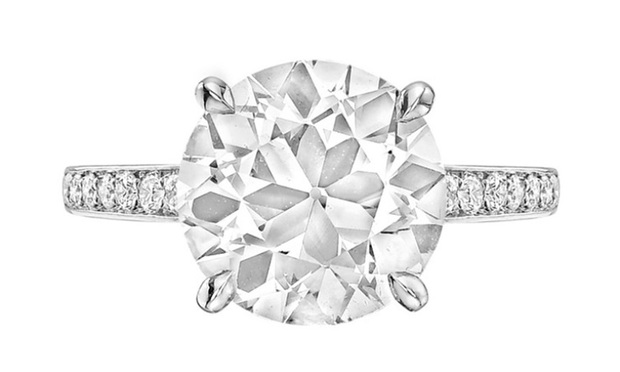Ouch, Babe. Big Law Associate Sues Ex-Fiancee Over $100K Engagement Ring
Troutman Sanders lawyer Ryan Strasser says the 4-carat diamond ring was a conditional gift that must be returned if the marriage failed to occur.
September 25, 2018 at 10:06 AM
6 minute read
 4.06 Carat Old European Brilliant Diamond Ring, Diamond engagement ring (Photo: Courtesy photo)
4.06 Carat Old European Brilliant Diamond Ring, Diamond engagement ring (Photo: Courtesy photo)
When Ryan Strasser, then an associate at Hogan Lovells in Washington, D.C., got down on one knee and asked Sarah Jones Dickens to marry him, he knew one thing: She'd like the ring.
It was 4.06 carats, a near-colorless, old European cut brilliant diamond, mounted in platinum with 14 diamond accents. And it fit what he says were her must-have requirements: 3.5 to 5 carats with an inclusion rating of no “worse” than VS2 and a color rating of no “worse” than G, and with no fluorescence.
The price? $100,000.
And then, 11 months later…they broke up.
According to Strasser, now an associate at Troutman Sanders in Richmond, Virginia, Dickens won't return the ring—which he's stuck paying off until 2020.
On Monday, he sued his ex-fiancée in U.S. District Court for the District of Columbia to force her to give it back.
Every lawsuit is a fight. Every lawsuit tells a story. But this one is a soap opera, a country-western song—and a cautionary tale of a big firm litigator who was seemingly taken to the cleaners by an art history student.
The key legal issue is fairly straightforward. Strasser, who is represented by Sheppard Mullin Richter & Hampton partner Steven Hollman (who overlapped with Strasser at Hogan Lovells for five years), argues that the engagement ring was a conditional gift that must be returned if the marriage fails to occur.
And in rich, painful (and possibly unnecessary) detail, Strasser lays out his version of how he was wronged.
The pair met in 2004 as college classmates at Duke. After graduation, she went off to study art history in Cambodia, and then enrolled in a Ph.D. program at Duke. He went to law school and also got a master's degree in public administration.
(In court papers, he listed his degrees in his personal email signature block. As in: “Ryan J. Strasser, Esq.; University of Pennsylvania, M.P.A. '11; Cornell Law School, J.D. '10; Duke University, B.A. '07.” )
They began dating in early November of 2015. She and her dog moved into his one-bedroom condo in Arlington, Virginia, where he lived with his two dogs. But the space felt a bit small and he said she convinced him to move. “Mr. Strasser was initially reluctant but succumbed to considering an alternative residency at defendant's repeated behest.”
They rented a five-bedroom house in a ritzy part of Washington, D.C.—or rather, Strasser rented it. He was the only one on the lease and paid all the bills, since Dickens was working on her dissertation and made no money.
According to Strasser, Dickens informed him that “she expected Mr. Strasser to propose to her with an engagement ring within one year of the start of their relationship.”
Dickens did not respond to requests for comment.
Strasser budgeted $40,000 for a ring—a bit less than the two-months-of-your-salary rule of thumb, but certainly enough for something nice.
Dickens allegedly wanted more. “Defendant insisted that she deserved a 'large' engagement ring because she did not believe in 'wasting' money on a wedding and so the parties should instead spend 'extra' on an engagement ring, something she would enjoy daily for the rest of her married life,” according to the complaint.
She found her dream ring at a store in Greenwich, Connecticut. “Although he repeatedly told [Dickens] that the price far exceeded his budget, Mr. Strasser eventually acceded and undertook to negotiate for the ring.”
He paid for it with his savings, two credit cards and a $30,000 personal loan which still costs him $912.71 a month in installments. Insurance on the ring is another $87.58 a month.
Strasser popped the question on February 9, 2017, and they did some preliminary wedding planning (the Park Hyatt in Beaver Creek, Colorado, or perhaps a ski chalet at Vail). They took engagement photos (birch trees, snow, mountains—see Exhibits 11 and 12. You know you want to look) and registered for gifts.
The complaint, alas, is silent on what exactly went wrong. “Eventually, the parties' relationship soured,” it states. On January 7, 2018, the bottom dropped out. Strasser reports that Dickens called his parents in New Jersey, telling them that he would “not stop crying,” and asked them to come and get him out of the house.
His parents came, her parents came, and the dads allegedly worked out a deal. She'd stay in the house a few months longer to finish her dissertation, and give the ring back when she moved out.
But then Dickens “abruptly proclaimed that she had changed her mind, that in her and her mother's view the engagement ring 'belonged to her' forever, that she would 'never give it back,' that the 'deal was off,'” the complaint states.
 Strasser moved out with only a few armfuls of clothing. After about two months, she let him into the garage to get some—but not all—of his belongings. The appendix has a sad list of what he says he is still missing, including his laptop, an All-Clad oversized soup pot and an autographed Christian Laettner photograph.
Strasser moved out with only a few armfuls of clothing. After about two months, she let him into the garage to get some—but not all—of his belongings. The appendix has a sad list of what he says he is still missing, including his laptop, an All-Clad oversized soup pot and an autographed Christian Laettner photograph.
Meanwhile, Strasser kept paying the rent on the house. When Dickens did finally move out, she didn't tell him—and left meat in the refrigerator, which was turned off. (Check out Exhibit 14 – there's a nasty photo). The smell was so bad that the landlord had to replace the appliance.
No doubt Dickens has a very different view of what happened and who was at fault—and may argue that if Strasser in fact dumped her, she should get to keep the ring.
Most courts have held that it doesn't matter who is at fault, and that an engagement ring is a conditional gift that must be returned if the marriage doesn't happen.
Still, the D.C. case that Strasser cites to support his argument isn't exactly on point—though he points to one from Maryland that is.
Which means we may not have heard the end of this fight yet.
Strasser's complaint is posted below:
We hope you enjoyed this excerpt from Litigation Daily, the exclusive source for sharp commentary on mega court battles, winning strategies and the issues that obsess elite litigators. Click here to subscribe.
This content has been archived. It is available through our partners, LexisNexis® and Bloomberg Law.
To view this content, please continue to their sites.
Not a Lexis Subscriber?
Subscribe Now
Not a Bloomberg Law Subscriber?
Subscribe Now
NOT FOR REPRINT
© 2025 ALM Global, LLC, All Rights Reserved. Request academic re-use from www.copyright.com. All other uses, submit a request to [email protected]. For more information visit Asset & Logo Licensing.
You Might Like
View All
Change Is Coming in the Trump Era. For Big Law, Change Is Already Here
6 minute read

'If the Job Is Better, You Get Better': Chief District Judge Discusses Overcoming Negative Perceptions During Q&A

The Growing Antitrust Scrutiny of DraftKings and FanDuel
Trending Stories
Who Got The Work
J. Brugh Lower of Gibbons has entered an appearance for industrial equipment supplier Devco Corporation in a pending trademark infringement lawsuit. The suit, accusing the defendant of selling knock-off Graco products, was filed Dec. 18 in New Jersey District Court by Rivkin Radler on behalf of Graco Inc. and Graco Minnesota. The case, assigned to U.S. District Judge Zahid N. Quraishi, is 3:24-cv-11294, Graco Inc. et al v. Devco Corporation.
Who Got The Work
Rebecca Maller-Stein and Kent A. Yalowitz of Arnold & Porter Kaye Scholer have entered their appearances for Hanaco Venture Capital and its executives, Lior Prosor and David Frankel, in a pending securities lawsuit. The action, filed on Dec. 24 in New York Southern District Court by Zell, Aron & Co. on behalf of Goldeneye Advisors, accuses the defendants of negligently and fraudulently managing the plaintiff's $1 million investment. The case, assigned to U.S. District Judge Vernon S. Broderick, is 1:24-cv-09918, Goldeneye Advisors, LLC v. Hanaco Venture Capital, Ltd. et al.
Who Got The Work
Attorneys from A&O Shearman has stepped in as defense counsel for Toronto-Dominion Bank and other defendants in a pending securities class action. The suit, filed Dec. 11 in New York Southern District Court by Bleichmar Fonti & Auld, accuses the defendants of concealing the bank's 'pervasive' deficiencies in regards to its compliance with the Bank Secrecy Act and the quality of its anti-money laundering controls. The case, assigned to U.S. District Judge Arun Subramanian, is 1:24-cv-09445, Gonzalez v. The Toronto-Dominion Bank et al.
Who Got The Work
Crown Castle International, a Pennsylvania company providing shared communications infrastructure, has turned to Luke D. Wolf of Gordon Rees Scully Mansukhani to fend off a pending breach-of-contract lawsuit. The court action, filed Nov. 25 in Michigan Eastern District Court by Hooper Hathaway PC on behalf of The Town Residences LLC, accuses Crown Castle of failing to transfer approximately $30,000 in utility payments from T-Mobile in breach of a roof-top lease and assignment agreement. The case, assigned to U.S. District Judge Susan K. Declercq, is 2:24-cv-13131, The Town Residences LLC v. T-Mobile US, Inc. et al.
Who Got The Work
Wilfred P. Coronato and Daniel M. Schwartz of McCarter & English have stepped in as defense counsel to Electrolux Home Products Inc. in a pending product liability lawsuit. The court action, filed Nov. 26 in New York Eastern District Court by Poulos Lopiccolo PC and Nagel Rice LLP on behalf of David Stern, alleges that the defendant's refrigerators’ drawers and shelving repeatedly break and fall apart within months after purchase. The case, assigned to U.S. District Judge Joan M. Azrack, is 2:24-cv-08204, Stern v. Electrolux Home Products, Inc.
Featured Firms
Law Offices of Gary Martin Hays & Associates, P.C.
(470) 294-1674
Law Offices of Mark E. Salomone
(857) 444-6468
Smith & Hassler
(713) 739-1250








